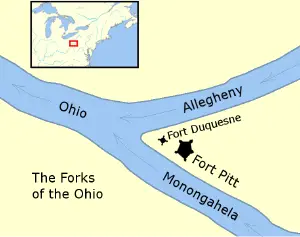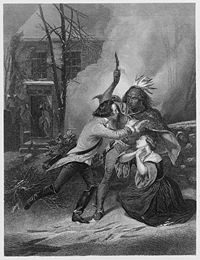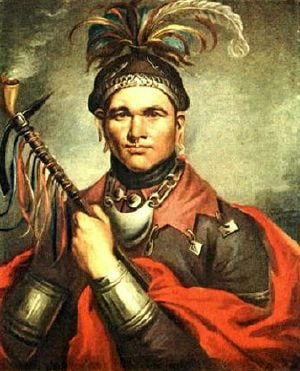Mary Jemison
Mary Jemison (1743 – 1833) was an American frontier girl who was kidnapped by French and Shawnee raiders, living out her life among the people of the Seneca Nation and later coming to know white settlers in New York, to whom she told her fascinating story.
Mary's Shawnee captors murdered her parents and several siblings, and then sold her to two Seneca women, who adopted her. She married twice and had eight children and numerous grandchildren. Her Seneca clan eventually settled in New York, where she came to own land and lived her later years among the white settlers there. She told her story to writer James Seaver in 1824, who published her story in a book and made her famous.
Jemison's story provided insights into the grave suffering of captives among the Native Americans and also into the lives of the Indians in general, and their women in particular. She is buried at Letchworth State Park on the grounds of a Seneca Council House, where a memorial to her is located and historical documents related to her life are kept. Mary Jemison's remains were relocated there by William Pryor Letchworth (for whom the park is named) and rededicated in 1872.[1]
Early life
Mary Jemison was born to Thomas and Jane Erwin Jemison aboard the ship William and Mary, in the fall of 1743, while en route from Northern Ireland to America. Upon their arrival, the couple and children, John, Thomas, Betsey, and Mary, their youngest, joined other Scots-Irish immigrants and headed west from Philadelphia, Pennsylvania, to what was then the western frontier (now central Pennsylvania). There, they squatted on territory that was under the authority of the Iroquois Confederacy. Mary's parents had two more sons, Matthew and Robert.
During the time the Jemisons were establishing their home in the frontier, the French and Indian War was raging. One morning in 1758, a raiding party consisting of six Shawnee Native Americans and four Frenchmen captured Mary, her parents, and siblings except her two older brothers, who hid in a barn and escaped to live with relatives.
On the route to Fort Duquesne—where the Allegheny and Monongahela Rivers meet to create the Ohio River in modern-day Pittsburgh—an even greater tragedy struck. Mary’s mother, father, Betsey, Matthew, and Robert, plus a neighbor woman and her two children, were killed in horrible ways and also scalped. Only Mary and a neighbor boy, young Davy Wheelock, were spared. Once the party reached the Fort, Mary was sold to two Seneca Indians, who took her down the Ohio river. The Senecas adopted Mary, giving her the name Corn Tassel, then later "little woman of great courage."
Life with Native Americans
Mary told her biographer James Seaver of her horrific kidnapping experience and how she watched her captors dry her parents' scalps on hoops by the fire. She suffered hunger and exhaustion on the long trek into the wilderness and finally was sold to the two Seneca sisters to replace their brother, who had died in battle against George Washington. She was later nearly taken back by settlers at the fort, but her new "family" spirited her away.
Mary reported that her new sisters treated her as if she was their actual sister. She quickly began to learn the language and to love them for their kind and protective treatment of her.
Mary was 17 when she was married to Sheninjee. Her husband's kindness won her heart and she reported that she truly loved him. Concerned that the end of the war would mean the return of captives and thus the loss of his young wife, Sheninjee took Mary on a difficult 700-mile journey to the Sehgahunda Valley along the Genesee River in New York. Although Mary reached this destination, her husband did not. He had left her with his brothers in order to hunt along the way, took ill, and died.
Now a widow, Mary was taken in by Sheninjee's clan and made her home at Little Beard's Town (present-day Cuylerville, New York). The stark life, simple food, and limited possessions showed the extreme suffering of the Native Americans in time of war and famine. She suffered in many ways but grew in strength and wisdom and lived for the sake of her children.
Mary related that the Indian women worked together as a team without a strong hierarchy but "elected" a leader for each work effort. The women helped complete each other's jobs, shared food, and exchanged stories as they worked. She said that no one felt "different" from the others, even herself as a white woman, but that all were part of a familial group. Men and women did separate jobs. She said that the women had some influence over the men as individuals, but the men, especially the leaders of the tribe or clan, made all the community-level decisions that affected the women.
While she was still young, the local Seneca chief wanted to ransom Mary to the whites, but her brother-in-law threated to kill her before he would allow her to be ransomed. Her sister then told her to hide in the woods with her baby and only return when it was safe. She reported being terrified during this ordeal. The chief indeed came to ransom her for money which Mary believed would have been spent on whiskey, but her brother's determination and her sister's help saved her, and she was able to live with her husband's family afterward until she remarried.
There, she was later married to another Seneca chief named Hiakatoo and had six more children. Her new husband was a leader in the Cherry Valley massacre during the American Revolutionary War, in which British and Seneca Native Americans attacked the fort and village of Cherry Hill in eastern New York on November 11, 1778. When revolutionary General John Sullivan's army retaliated and destroyed her town, Mary was then required to move to the Gardeau Flats near Castile, New York.
Mary also told Seaver the terrible story of how her son, John, killed his brother and cousin in a jealous rage and then died a violent death himself. Despite having her heart broken in these and other ways throughout her life, she was remembered by those who knew her, both Native American and white, as as a constantly generous, and kind woman.
Later life
Much of the land at Little Beard's Town was sold by the Senecas to white settlers in 1797. By 1823, most of the remainder of the land was sold, except for a two-acre tract reserved for Mary's use. She owned the largest herd of cattle in the region due to a 1797 tribal grant which made her one of the largest landowners. Her land title was confirmed by the state in 1817, at which time she became a naturalized U.S. citizen. Known locally as the "White Woman of the Genesee," Mary lived on the tract until she sold it in 1831, and moved to the Buffalo Creek Reservation with her family. She was noted for her generosity and cheerfulness, and was said to be physically vigorous well into her 80s.
A writer named H.A. Dudley published a report, in 1893, describing his meeting Mary Jemison when visiting with his aunt, Mary called his aunt "the woman who had hair just like my mother's."
The old woman (Mary) would stroke the auburn tresses, and sit down on her low and well-worn rocking chair and croon over her reflections of the mother who charged her, when ruthlessly separated in the woods of Pennsylvania, not to forget the name of her childhood, nor the prayers she had taught her in the pioneer home which had that day been burned to the ground.[2]
At that first visit, Dudley reported, Mary was small in height—another report described her as four and a half feet tall—and dressed in Indian clothing with moccasins, pantaletts or buckskin, petticoats, and an overgarment for her body with shoulders. She also wore a blanket when she went outside.
At this time, Mary lived with her daughter, Polly, her sons, Tom and John, and perhaps some others. However, the boys would disappear as soon as any white visitors came and not return until the guests left. Polly would stay doing work around the house while the visitors talked, but she seemed "relieved" when they left.
When white friends came to visit on Sundays, Mary, normally reserved, would sometimes open up and talk about her life. She reported that she had tried once to go back and live among white people but could not. Her mixed-race children would not be accepted and she had grown accustomed to the style and habits of the Indians. She said she was just "too old now to learn again the ways of the whites." She also loved her beautiful acres, which were her home, so she stayed where she was with the Native Americans.
By 1830, only white farmers remained in the area. They reportedly looked with "envious eyes" on her rich bottom lands, which were underused by her family. She was said to be "white woman enough to own her own land, but too much of an Indian to work it profitably."[3] She then decided to move with the Indians to the reservation near Buffalo, New York. So she sold her pleasant home and went with her tribe to the reservation.
Another account of Mary came through businessman William Pryor Letchworth who asked local resident, William B. Munson, to describe the woman he had known as a young man. His account appeared in Doty's History of Livingston County.
The "White Woman" was quite intelligent, sociable, and communicative, but grave and serious after the manner of the Indians with whom her life from early childhood had been spent… Mentioning to her upon one occasion that I had read the history of her life, and that it had interested me very much, "Ah, yes!" she replied, "but I did not tell them, who wrote it down, half of what it was." It was thought at that time that she withheld information the Indians feared might stir up against them the prejudices of the white people.[4]
The descendants of a man who knew her, Truman Stone, tell of a time of famine, when their great-grandfather went looking for grain. He walked 25 miles and found that no one had enough to sell. When he finally met Mary Jemison she gave it freely and refused to take any money from him. He reported that she fed him some Native American cake made of cracked corn with a little salt added and baked in a kettle. "After the cake was done, she broke a goose egg into the kettle and fried it… she invited me to eat, which I did, and it was the best dinner I ever ate."
Mary lived the rest of her life with the people of the Seneca Nation near Buffalo until she died on September 19, 1833. She was initially buried on the Buffalo Creek Reservation, but in 1874, this land was about to be sold with little concern for the graves there. Her grandchildren approached businessman Letchworth to see if her bones could be moved. He invited them to bring the bones of their grandmother to his Glen Iris estate. Her remains were placed in a new walnut coffin and brought by train by her grandchildren. She was re-interred at this location, which is now Letchworth State Park in present day Castile, New York.
Ceremonies for her reportedly blended both the Seneca and Christian ways. Dehgewanus (Mary) was buried on the bluff above the Middle Falls. A bronze statue of her, created in 1910, now marks her grave. Historical documents concerning her life story are kept in the library at Letchworth State Park.
Seaver's biography
Mary Jemison's story is told in a classic "captivity narrative," J.E. Seaver's Narrative of the Life of Mrs. Mary Jemison (1824; latest ed. 1967), considered by most scholars to be a reasonably accurate account. She spent a good deal of time telling her story to Seaver, who worked on it from 1823 to 24. It was enormously popular and eventually had 30 editions. In it, she related the extreme suffering during her capture and subsequent travels in the wild and the horrific torture and suffering of other captives. Yet she also told of kindness and love from her Seneca "family" and also of her second husband.
According to Seaver, when setters moved into the Genessee valley seeking good farmland, "She was the protectoress of the homeless fugitive, and made welcome the weary wanderer. Many still live to commemorate her benevolence towards them, when prisoners during the war, and to ascribe their deliverance to the mediation of The White Woman."[5]
Seaver writes that the Peace of 1783 brought an end to the hostilities between the Native Americans and European settlers, which allowed many captive whites to return to their friends and families. Stories began to spread about the horrific experiences these survivors had endured and the sad demise of many of their friends and families. It was this situation that led him to interview Mary Jemison.
He describes Jemison as,
speak[ing] English plainly and distinctly, with a little of the Irish emphasis, and has the use of words so well as to render herself intelligible on any subject with which she is acquainted. Her recollection and memory exceeded my expectation. It cannot be reasonably supposed that a person of her age has kept the events of seventy years in so complete a chain as to be able to assign to each its proper time and place; she, however, made her recital with as few obvious mistakes as might be found in that of a person of fifty.
He adds, "Her ideas of religion, correspond in every respect with those of the great mass of the Senecas. She applauds virtue, and despises vice. She believes in a future state, in which the good will be happy, and the bad miserable; and that the acquisition of that happiness, depends primarily upon human volition, and the consequent good deeds of the happy recipient of blessedness. The doctrines taught in the Christian religion, she is a stranger to."
Her children
- A girl who lived two days, 1761
- Thomas Jemison, son of her first husband, Sheninjee; named after her beloved father, died young of fever
- John, born in 1766, son of Hiokatoo; killed in 1817
- Nancy, first daughter to Hiokatoo, born in 1773, died in 1839
- Betsey, date uncertain but presumed after Nancy but before Polly; died in 1839
- Polly, born late in 1778 or early in 1779; died 1839.
- Jane, born in 1782, died in 1897
- Jesse, born in 1784 or 1785; killed by his half-brother, John, in 1812
(No reason is given for the deaths of three daughters within three months of each other. It is likely, however, that they died of an epidemic on the Buffalo Creek Reservation.)
The English names for these children reflect their white family history, but the children also had Seneca names. According to treaty documents, Thomas, for example, was known to the Senecas as Teahdowaingqua.[6]
Legacy
Mary Jemison's tale gave important insights into the suffering of white captives taken by Native Americans. Her story, as told to James Seaver, showed the life of the Indians in the Northeast of the United States and added much information about the culture, beliefs and practices of the Senecas and other tribes.
Her story has also been used in women's studies to highlight the lives of women, especially Indian women, of the time.
She was known as "Dehgewanus, The White Woman of the Genesee." A granite marker was erected in the 1880s at her grave site in Lechtworth State Park, and the statue was dedicated in 1910. Artifacts, documents, and primary sources are kept in the Letchworth State Park Historical library.
Notes
- ↑ Letchworth Park History, The Council Grounds. Retrieved July 24, 2008.
- ↑ H.A. Dudley, Livingston Republican (1893).
- ↑ Ibid.
- ↑ Letchworth Park, History of Mary Jemison. Retrieved July 2, 2008.
- ↑ Ibid.
- ↑ Seaver, 1824.
ReferencesISBN links support NWE through referral fees
- Beauchamp, William. History of the New York Iroquois. Ira J. Friedman, Inc., 1963.
- Namias, June. White Captives: Gender and Ethnicity on the American Frontier. Chapel Hill: University of North Carolina Press. 1993. ISBN 978-0807844083.
- Seaver, James. A Narrative of the Life of Mrs. Mary Jemison. New York: American Scenic & Historical Preservation Society, 1942.
- Strong, Pauline Turner. Captive Selves, Captivating Others: The Politics and Poetics of Colonial American Captivity Narratives. Westview Press, 2000. ISBN 978-0813316666.
- Volo, James M., and Dorothy Denneen Volo. Daily Life on the Old Colonial Frontier. Greenwood Press, 2002. ISBN 978-0313311031.
External links
All links retrieved April 29, 2025.
- Letchworth State Park, Glimpses of the Past. www.letchworthparkhistory.com
- Photograph of Mary as an old woman. www.letchworthparkhistory.com
Credits
New World Encyclopedia writers and editors rewrote and completed the Wikipedia article in accordance with New World Encyclopedia standards. This article abides by terms of the Creative Commons CC-by-sa 3.0 License (CC-by-sa), which may be used and disseminated with proper attribution. Credit is due under the terms of this license that can reference both the New World Encyclopedia contributors and the selfless volunteer contributors of the Wikimedia Foundation. To cite this article click here for a list of acceptable citing formats.The history of earlier contributions by wikipedians is accessible to researchers here:
The history of this article since it was imported to New World Encyclopedia:
Note: Some restrictions may apply to use of individual images which are separately licensed.



